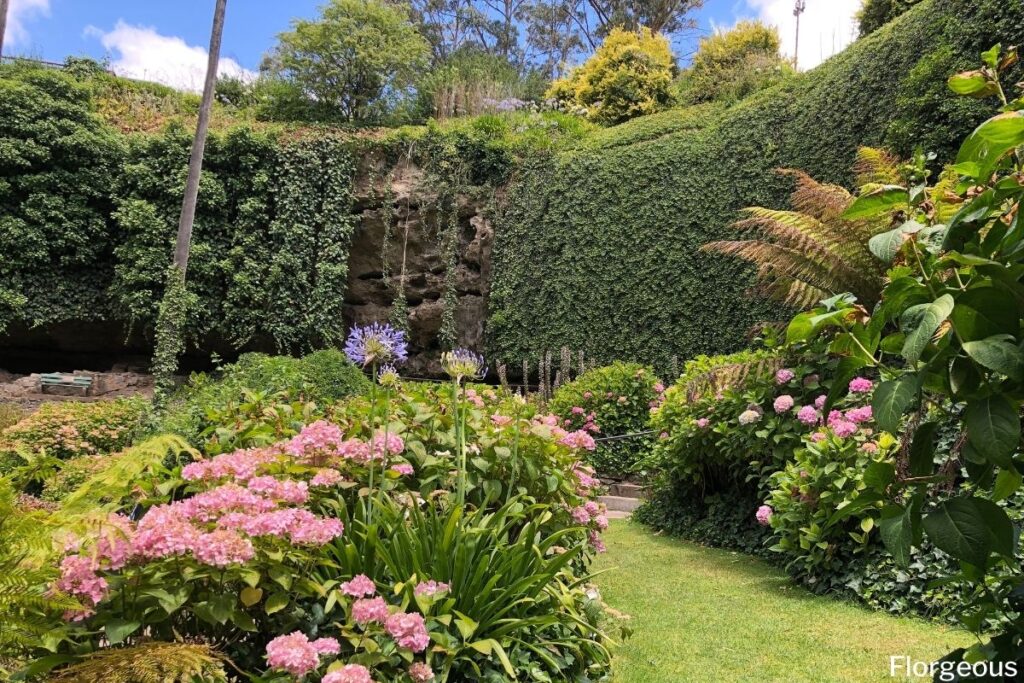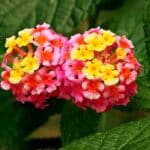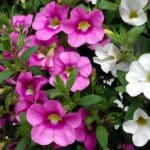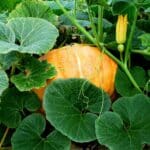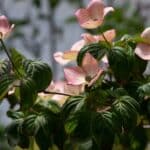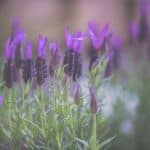Shrubs can be a great addition to any backyard garden and can make an ordinary landscape look professional. Whether you are looking for bushes for front yard, garden shrubs or landscaping bushes, we have a great list for you.
Shrubs can be used to section off areas of your yard, add a little bit of privacy, or to add some mature looking plants to your backyard. Whatever your reasoning, there are types of shrubs that are ideal for your yard.
What Makes a Shrub, a Shrub?
You might be wondering, what is a shrub, or what distinguishes a shrub from a bush? The answer is that there really isn’t a difference. Informally, a shrub is just a small -to medium- sized bush that is generally more uniform and well-maintained.
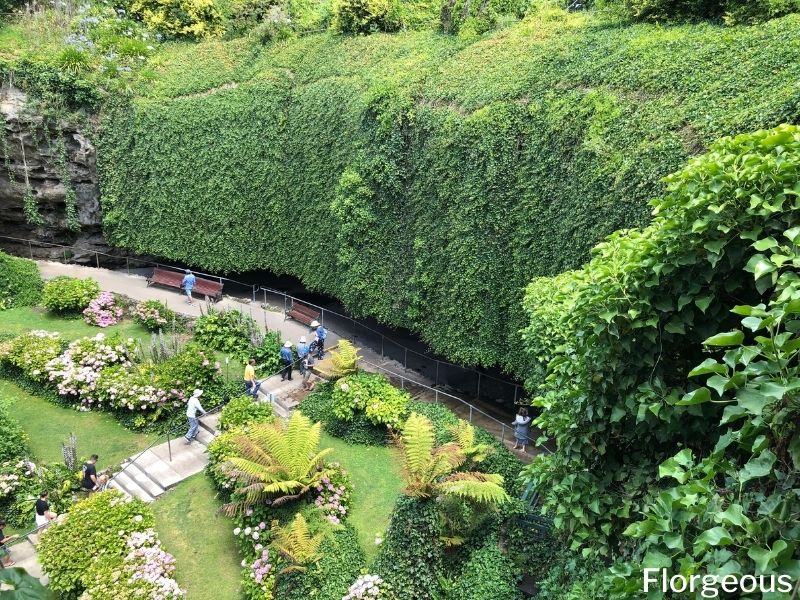
As for flowering shrubs, they differ from your average perennial in the way that they have woody stems that grow above ground and branch out, similar to a tree.
So what’s the difference between a shrub and a tree? Trees generally have one large “stem” that we call the trunk, and its branches generally only grow on the top half of the trunk. When it comes to shrubs, branches are more densely populated and will grow much closer to the ground.
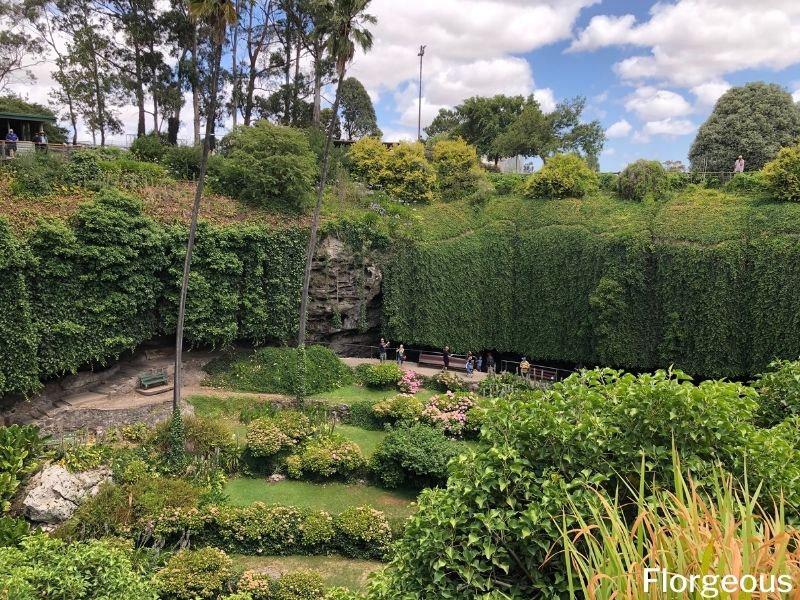
Best Bush and Shrubbery Types to Grow in Your Backyard Garden
Here are the most common types of shrubs and bushes you can grow:
1. Arborvitae Evergreen Shrub
The arborvitae is an evergreen shrub, which means it will be green all year round. This is ideal for those who are using these shrubs for a little bit of privacy; your need for privacy doesn’t go away in the winter.
A nice aspect of the arborvitae is that they grow in a nice cone shape with little to no trimming needed. Once mature, they become a very hands-off shrub that is easy to care for.
These perennial shrubs love well-draining soil.
2. Lilac Shrub
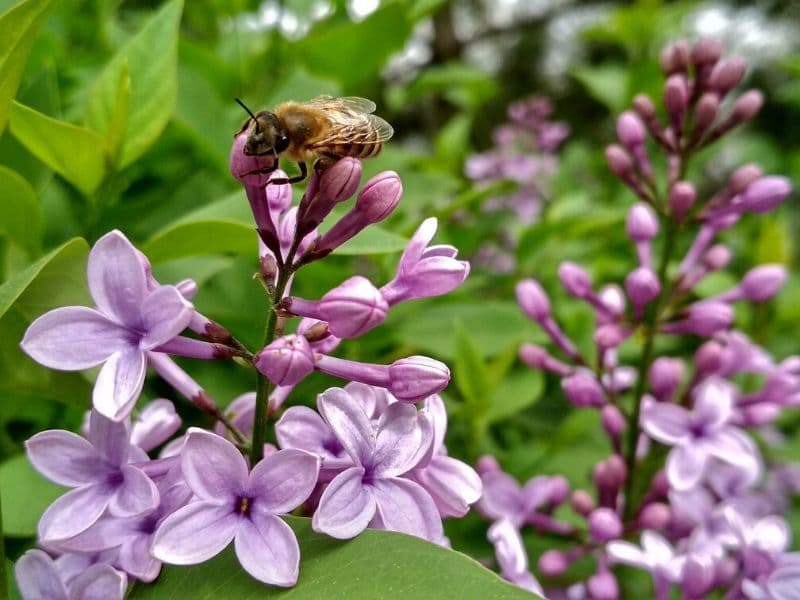
Lilac shrubs, or Syringa vulgaris, produce a beautiful purple flower that smells amazing. They are fairly easy shrubs to grow and are a popular choice for their flowers.
The flowers will only bloom in the spring, and fall off all too soon, but they’re worth the wait. The shrubs do tend to look a little more unruly than what you might expect from a shrub, but with some trimming will make a beautiful addition to any backyard.
This ornamental shrub likes well-draining soil.
3. Hydrangea Shrub
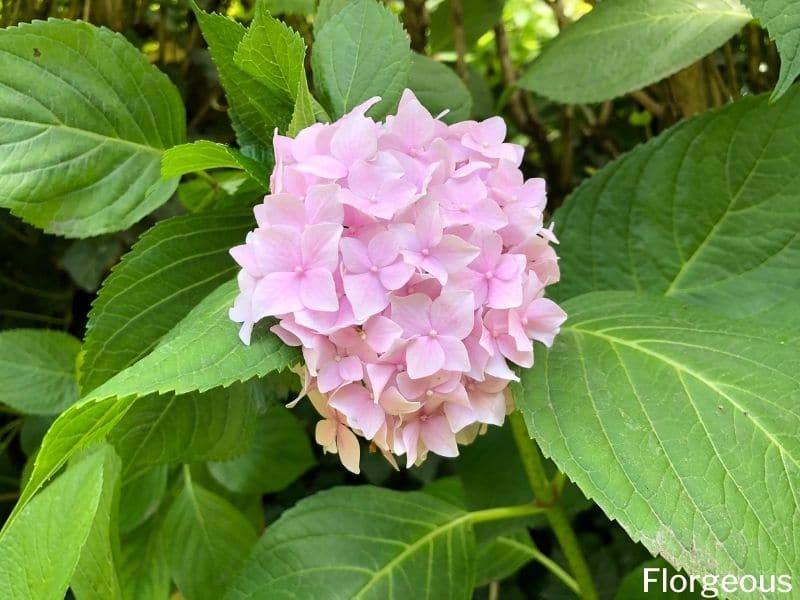
Another beautiful choice for their flowers, hydrangea shrubs, come in a large variety. There’s a hydrangea shrub for nearly any color scheme you are planning.
The shrubs themselves are fairly simple to care for, and won’t require much maintenance, but to keep those beautiful flowers blooming, a little more effort is required. To keep your hydrangea blooms big and beautiful, special fertilizers may come in handy.
4. Blue Star Juniper Shrub
If you are looking for a low maintenance evergreen shrub, the blue star juniper may be for you. These shrubs have an almost silver tint to their blue-green foliage, giving them a unique look that stands out in your garden.
This juniper shrub tends to plant it and leave it kind of shrub, and won’t require much of your attention. They get their name from the star shape they grow in, which is best viewed from above.
5. Rose of Sharon Ornamental Shrub
Who wouldn’t want tropical-looking flowers in their backyard? If you don’t live somewhere tropical, the Rose of Sharon shrub is derived from the tropical hibiscus flower, and was bred to thrive in regions that have a cold winter.
Rose of Sharon shrubs can grow to be fairly tall, and are sometimes mistaken to be a tree. If you trim your Rose of Sharon shrub correctly, you can keep it lower to the ground so it appears more shrub-like.
6. Common Boxwood Shrubs
Boxwood shrubs are a fairly popular choice due to their versatile nature. They are an evergreen shrub, which will add color to your garden even in the winter time.
One of the most popular evergreen shrubs, boxwood is prized for its dense foliage and ability to be shaped into formal hedges and topiaries. It can grow up to 20 feet tall and wide, and prefers well-draining soil.
Boxwood shrubs are easily manipulated with trimmers, and are a good choice for creating topiaries in your yard. They do produce very small yellowish flowers in the springtime, but are primarily grown for their thick foliage.
Boxwood is another shrub species that is very easy to care for, and won’t require much intervention to grow well.
The common boxwood scientific name is Buxus sempervirens.
7. Rhododendron spp.
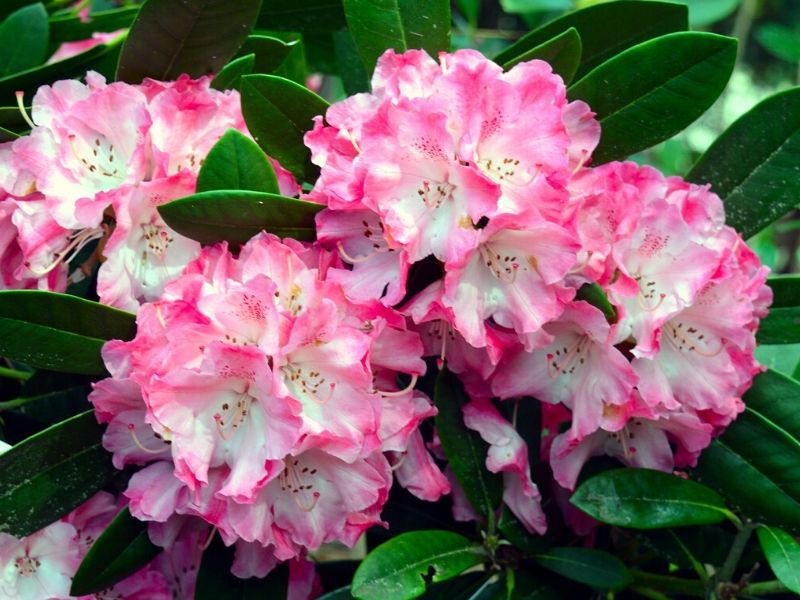
Rhododendron shrubs are yet another highly popular shrub choice, primarily for their beautiful blooming flowers. Rhododendron shrubs do require a little bit of planning, as they are picky when it comes to the pH of your soil. These shrubs require a pH between 4.5 and 5.5 to thrive and bloom.
Testing your soil before planting is an important step for the Rhododendron shrubs, but don’t worry too much if your soil doesn’t test well, there are additives that can alter the soil pH.
8. Spirea Shrubs
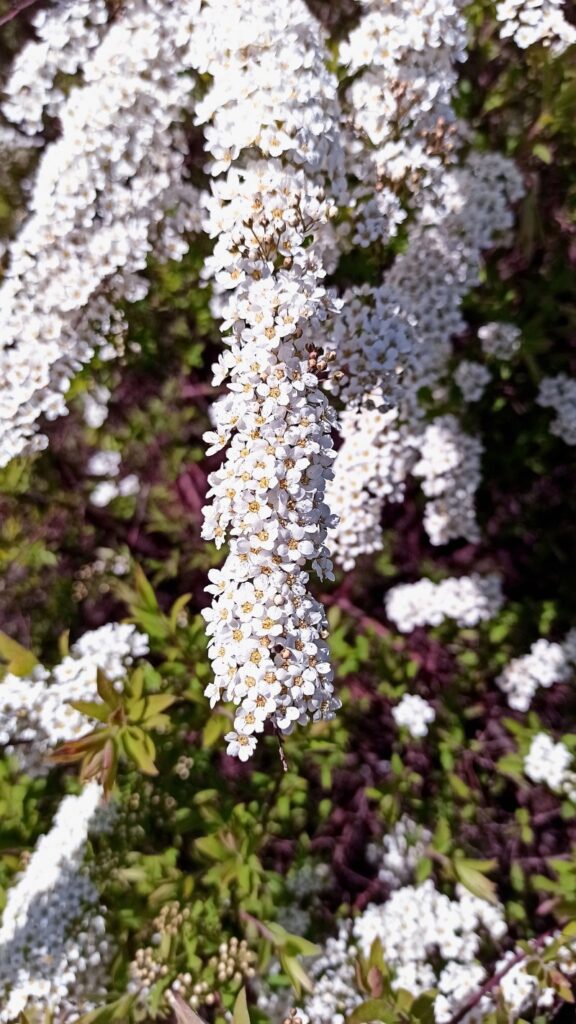
Spirea is a popular variety of shrub for a classic backyard garden. There are multiple types available, including ones that rebloom so you enjoy color all season long.
The plant produces flower sin shades of white, red, and pink, all of which show up nicely against a lime-green background of dense foliage. It is a cold-hardy plant that does well as foundation planting or when grown to line a walkway. It is a hardy and reliable bloomer, too, hardy in zones 3 to 8.
9. Flowering Quince Shrubs
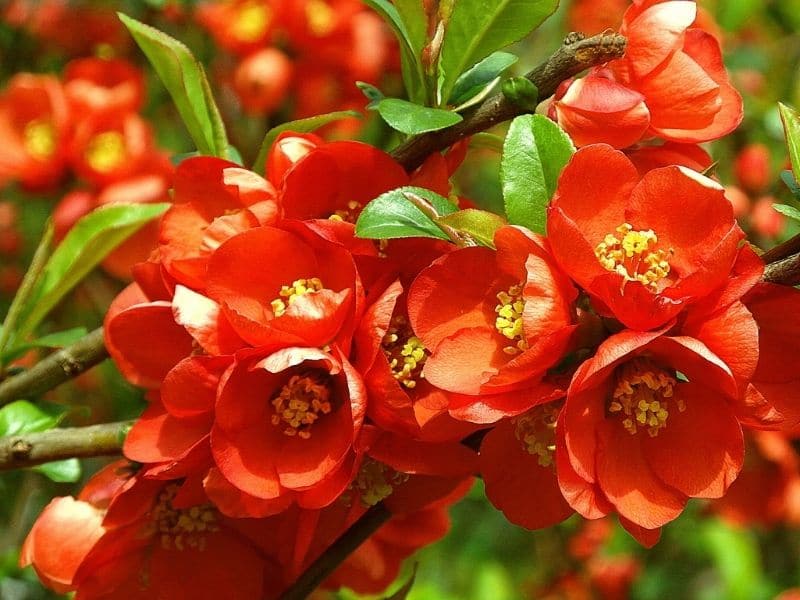
Flowering quince is another lovely shrub that is easy to care for – and therefore perfect for a novice backyard gardener! With large, ample flowers that are produced primarily in the early spring, this plant can be found in all kinds of shapes, colors, and flowers. It seldom needs pruning and there are some varieties that are completely thornless, too.
You can grow this shrub anywhere from zone 5 to 9, but keep in mind that in a warmer climate, you may want to provide it with some afternoon shade – this will extend the duration of your blooms.
10. Ninebark Shrubs
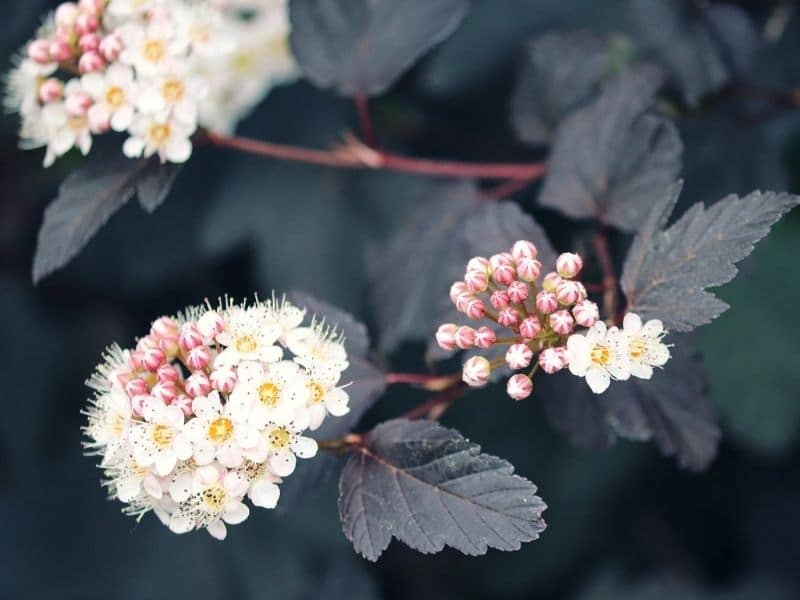
Ninebark is a native plant with gorgeous burgundy foliage. It does also produce white flowers, but the plant is prized more for its foliage, since it hangs on all year long while the flowers tend to die back a bit.
A super weather resistant shrub, it grows well in zones 2 through 7. Some of the most popular cultivars include ‘Center Glow’ and ‘Diablo,’ but you’ll have plenty of color regardless of which one you happen to choose.
11. Pink Flowering Almond Shrubs
The pink flowering almond is a gorgeous shrub you can grow, a plant that many gardeners actually view as a tree. It’s only drawback is that it’s somewhat of a one-hit-wonder, producing gorgeous colors primarily in the spring.
As soon as the spring flowers fall away, the shrub tends to fade into the backdrop, not offering a lot of color. Nevertheless, this shrub is a favorite of backyard gardeners because it grows rapidly and holds up well to dry spells. It is hardy in zones 4 through 8 and likes rich, well-drained soil.
12. Forsythia Shrubs
Forsythia is one of the first plants to bloom in print, producing gorgeous yellow blooms (and lots of them!) on tiny little stems. Despite the shockingly high number of flowers that this plant produces, it doesn’t take up a lot of space.
In fact, forsythia is a compact plant that easily can be trained into a hedge form, and there are also dwarf shrub types available, too. It grows well in full sun and is hardy in zones 5 to 8.
Great for formal gardens, the forsythia scientific name is also Forsythia suspensa. Easy to remember!
13. Deutzia Shrubs
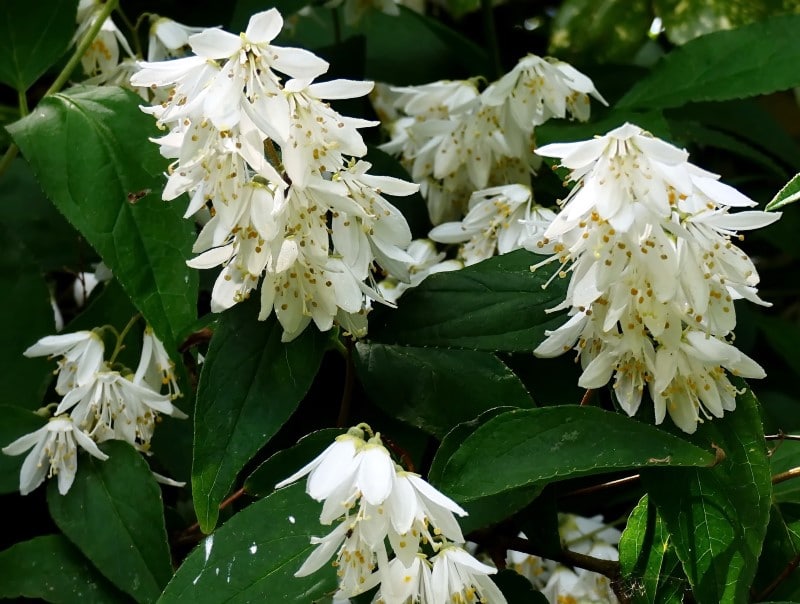
A mounded shrub, deutzia produces arching branches that become loaded with white- or blush-colored flowers first thing in the spring – these turn a deep burgundy color in the fall.
Some grow low to the ground and are perfect ground covers or foundation plantings. Hardy in zones 5 to 8, the deutzia family includes many popular cultivars, including ‘Nikko Blush’ and ‘Yuki Cherry Blossom.’
The deutzia scientific name is, of course, just Deutzia– the perfect name for these beautiful shrubs!
14. Rose Bushes
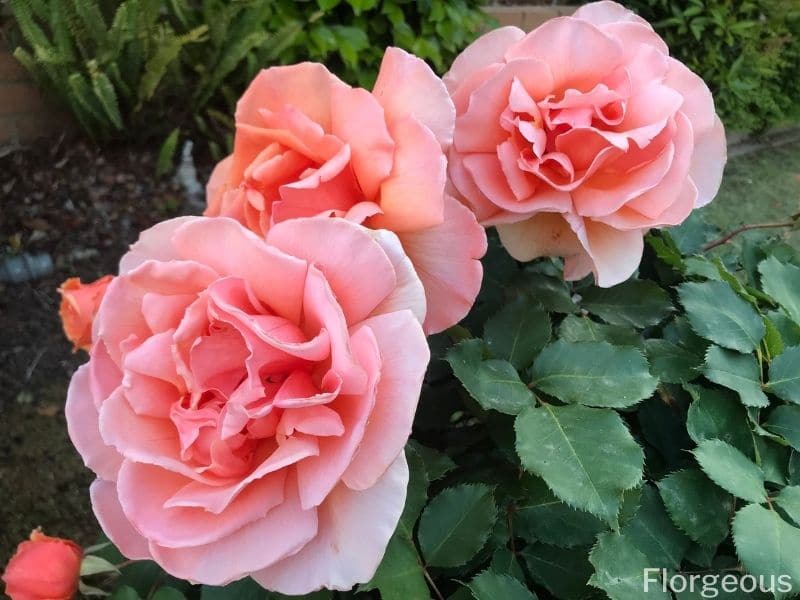
When in doubt, you may want to turn to good old fashioned roses to fill in the bare spots of your backyard.
Rose bushes are generally classified as deciduous shrubs, prized for their beautiful appearance and heavenly aroma. There is a common misconception that roses are difficult to grow, but that’s really not the case.
Certain types, like Double Knockouts, or more or less “plant them and leave them” kinds of shrubs. They are hardy in a wide range of growing zones, too, all the way from zone 3 to zone 11 depending on the type. Full sun and acidic soil is all you need to be successful!
15. Pearl Bush Shrubs
Pearl bush is another classic favorite of backyard gardeners, producing dozens of tiny white flowers in the spring. A great border specimen, pearl bush does well in a hedge, too, but can also be grown as an individual specimen. It’s compact enough to fit in crowded backyard spaces and is hardy in zones 4 to 8.
16. Beautyberry Shrubs
Beautyberry, as the name suggests, is another plant that is known for its lovely purple berries. This plant produces gorgeous foliage, too, with some types growing leaves that are a stunning black-purple color. It is hardy in zones 5 to 8 and also grows white flowers in the late summer as long as it is grown in full sunlight.
The American beautyberry scientific name is Callicarpa americana.
17. Double Viburnum Shrubs
Double Viburnum is another shrub that is easy to grow for most novice gardeners. It is the perfect planting for a sunny location with flowers that line up in double rows along the branches. It has an unusual appearance that is charming and lovely to behold. This shrub is hardy in zones 5 to 8 and prefers well-drained, loamy soil.
18. Weigela Shrubs
There are dozens of different varieties of weigela, a popular shrub that blooms first thing in the late spring. Many of these varieties continue to bloom all the way until the first frost!
You’ll find the best and most beautiful colors appearing on plants grown in full sunlight, but the plant can tolerate partial shade in a super hot climate. It is an attractive plant that is often used to produce a privacy screen for urban backyard growers. It is hardy in zones 4 to 8.
19. Azalea Bushes and Shrubs
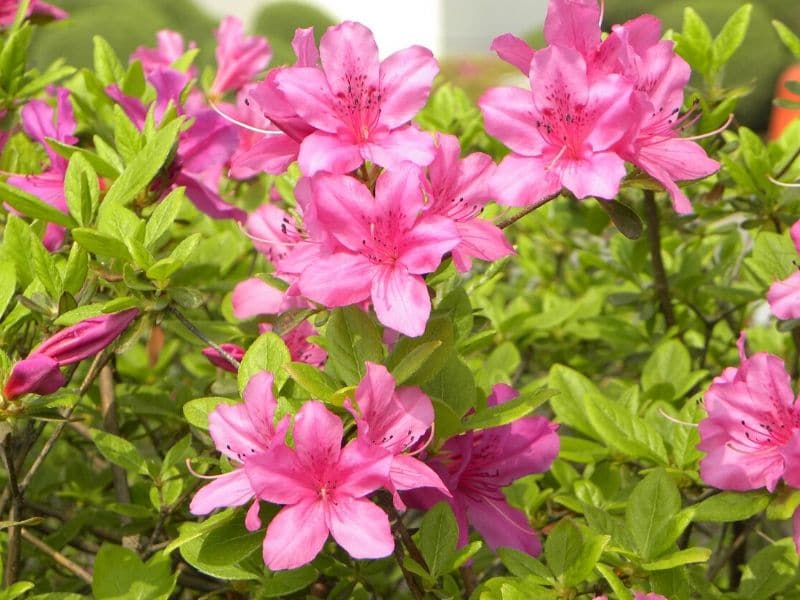
One of the most popular shrubs of all time, the azalea is a shrub that produces flowers all spring and summer long. It looks fantastic in a mass planting but can also be grown by itself.
One of the best ways to grow azaleas, though, is in a low hedge. This shrub is available in both deciduous or evergreen varieties, and there are even re-blooming cultivars that will offer consistent shades of coral, pink, purple, peach, or white regardless of the season.
20. Camellia Bushes and Shrubs
The camellia, or Camellia japonica, is a flowering shrub that tends to bloom at unexpected times – for most people, right around the holidays! That offers gardeners a serious benefit in that you don’t have to wait for summer to enjoy the beauty of a shrub garden.
You can grow this plant anywhere in zones 7 to 9. It offers a beautiful fragrance that mimics that of a rose and sometimes blooms into the early spring, too.
21. King’s Gold Shrubs
King’s Gold is often confused for being an ornamental grass, but that’s not the case. This shrub produces lovely leaves that can be green or golden depending on the time of year.
A popular shrub, this plant’s golden foliage is eye-catching, particularly when paired with other kinds of shrubs and trees like Blue Star Juniper or red barberry. It is hardy in zones 4 to 8.
22. Koreanspice Viburnum Bushes and Shrubs
Viburnum is one of the toughest shrubs you can grow in your backyard garden, and Koreanspice Viburnum is truly no exception. It is a spring bloomer that produces gorgeous white or pink-white blooms with a spicy aroma and gorgeous red foliage in the fall.
This plant can tolerate some shade – but no matter where you decide to grow it, make sure you plant it somewhere in which you’ll be able to enjoy the fragrance as part of your shrub garden. It’s hardy in zones 4 to 8.
23. Caryopteris Shrub
A popular sun-loving shrub, caryopteris produces gorgeous blue blooms from the late summer until the early fall. This is the ideal time, since most shrubs, by this point, have already stopped blooming.
That’s definitely not the case with caryopteris, a plant that bees, butterflies, and other pollinators will flock to in droves. This plant is absolutely striking when planted in a large group or on a border. It is hardy in zones 5 to 9.
24. Mountain Laurel Deciduous Shrub
Mountain Laurel, Kalmia latifolia, as you might expect from the name alone, is a shrub that prefers to be grown in a shadier location. It is a broadleaf evergreen that you may find similar in care requirements and appearance to certain types of rhododendrons and azalea. This plant can be grown in zones 4 to 9 and likes partial shade along with well-draining, acidic soil.
25. Oakleaf Hydrangea Bushes and Shrubs
Another hydrangea, you might be asking? Well – sort of. The oakleaf hydrangea is a whole new type of hydrangea, according to many gardeners, because it is a lovely four-season shrub that offers fall foliage similar to the best fall foliage tree species in the autumn months.
Not only that, but it produces large flower heads each summer. It offers interest throughout the spring and winter months, too, as it has lovely peeling bark. This shrub isn’t hardy everywhere, though – unfortunately, it can only be grown in zones 5 to 9, for the most part.
26. Butterfly Bushes
Butterfly bush, also called summer lilac, is aptly named in both regards. Not only will it attract hordes of pollinators to your garden (and not just butterflies, either, but also bees and hummingbirds, too) but it produces gorgeous clusters of flowers that look a lot like those of your favorite lilac bush.
This plant blooms all season long and while it can grow quite large, there are dwarf cultivars you can choose from that won’t hog all of your garden space. It grows best in a mass planting or in a border, producing white, purple, or pink flowers when grown in partial shade.
27. Buttonbush Shrubs
There’s very little not to love about the charming buttonbush plant. This plant loves being grown in wet soil, so you’re best placing it around the perimeter of your house ideally near a downspout.
There are several types of buttonbush for you to choose from, but one of the most popular is the native variety – a cultivar that can grow to well over 20 feet tall! Therefore, you’ll want to be mindful of where you plant it so that it doesn’t overtake your other plantings.
If a massive shrub isn’t what you had in mind, keep in mind that there are dwarf flowering shrub varieties available of this shrub, too, most of which produce beautiful red fruits and white flowers in the fall. It is hardy in zones 4 to 10.
28. Abelia Bushes and Shrubs
A gorgeous shrub for just about any backyard, Abelia produces lovely purple, pink, and peach-colored flowers at the end of the spring. These flowers have a unique aroma – one that is equal parts sweet and spice.
There are several types of abelia you can grow, with the newer cultivars being a bit more cold-hardy. You can plant it in a border or as a specimen planting all by itself. Either way, make sure it’s in full view – you’ll want to enjoy these scented flowers whenever you step outside! It is hardy in zones 4 to 9.
29. Red Twig Dogwood Shrubs
Red twig dogwood is a shrub that is frequently grown for its ornamental value, but not in the traditional sense that you’ve come to expect from other shrubs.
While most shrubs are grown for their flowers or foliage, that’s not the case with red twig dogwood, which is instead grown for the color of its bark. It has bright red bark that remains bright and vibrant even through the darkest winter months. Its foliage isn’t anything to ignore, either, with bicolored green and white leaves that fall back each autumn.
It’s recommended to grow this plant along with other red twig dogwood companion plants to make a beautiful landscape.
30. Sweetshrub Plants
Sweetshrub is a tropical-looking plant that grows well in more moderate climates – in fact, it’s hardy in zones 5 to 9.
This shrub goes by other names, too, including Carolina allspice, sweet bubby, and strawberry bush (the latter being the most confusing of all three monikers!). It grows well as a border specimen and will attract all kinds of pollinators and wildlife to your lawn with its unique seed capsules and flowers.
31. Chinese Fringe Flower Shrub
This evergreen shrub is known for its stunning pink, white or red fringe-like flowers that appear in early spring. It can grow up to 6 feet tall and 4 feet wide, and prefers well-draining soil.
So what’s the Chinese fringe flower scientific name? None other than Loropetalum chinense.
32. Banana Shrubs
Native to China, this fragrant shrub gets its name from its banana-scented flowers that bloom in early spring and summer. It can grow up to 15 feet tall and 10 feet wide, and prefers well-draining soil.
As for the banana shrub scientific name, that’s Michelia figo.
33. Bay Laurel Shrubs
Also known as sweet bay or bay tree, this evergreen shrub is prized for its aromatic leaves that add flavor to soups, stews, and sauces. It can grow up to 30 feet tall and 20 feet wide, and prefers well-draining soil.
The bay laurel scientific name is Laurus nobilis.
34. Crape Myrtle Bushes and Shrubs
The Crape Myrtle scientific name is Lagerstroemia indica.
These flowering plants are known for their vibrant, long-lasting blooms in shades of pink, purple, red, and white. They can grow up to 25 feet tall and 20 feet wide, and prefer well-draining soil.
35. Firecracker Flower Shrubs
This tropical shrub produces clusters of bright orange or yellow flowers that attract hummingbirds and butterflies. It can grow up to 3 feet tall and wide, and prefers well-draining soil.
The firecracker flower scientific name is Crossandra infundibuliformis.
36. Angel’s Trumpet
Known for its trumpet-shaped flowers that can reach lengths of up to 10 inches, this tropical shrub, Brugmansia spp., is a showstopper in any garden. It can grow up to 15 feet tall and wide, and prefers well-draining soil. However, it should be noted that all parts of the plant are toxic if ingested.
37. Shrubby Cinquefoil
This hardy shrub, Potentilla fruticosa, produces bright yellow or pink flowers throughout the summer months. It can grow up to 4 feet tall and wide, and prefers well-draining soil.
38. Gardenia
Known for their fragrant white flowers, gardenias are popular ornamental shrubs that can be grown as a standalone specimen or as part of a mixed border. They can grow up to 6 feet tall and wide, and prefer well-draining soil.
The gardenia scientific name is Gardenia jasminoides.
39. Cotoneaster
This low-growing shrub produces bright red berries in the fall and winter that attract birds. It can grow up to 3 feet tall and 6 feet wide, and prefers well-draining soil.
The cotoneaster scientific name is Cotoneaster horizontalis.
40. Andromeda
Known for its vibrant clusters of white, pink, or red flowers, andromeda is a popular choice for shaded gardens. It can grow up to 12 feet tall and 8 feet wide, and prefers well-draining soil.
The andromeda scientific name is Pieris japonica.
41. Bush Honeysuckle
This native shrub, Diervilla lonicera, produces clusters of yellow flowers in the summer and red fall foliage. It can grow up to 5 feet tall and wide, and prefers well-draining soil.
42. Japanese Quince
Known for its reddish-pink flowers that bloom in early spring, this thorny shrub, Chaenomeles japonica, can be grown as a standalone specimen or trained against a fence or wall. It can grow up to 10 feet tall and wide, and prefers well-draining soil.
43. Red Osier Dogwood
This fast-growing shrub, Cornus sericea, is known for its bright red stems that add winter interest to the garden. It can grow up to 10 feet tall and wide, and prefers well-draining soil.
44. Spotted Laurel
This evergreen shrub, Aucuba japonica, produces glossy green leaves with yellow spots and red berries in the fall and winter. It can grow up to 10 feet tall and 8 feet wide, and prefers well-draining soil.
How to Care for Shrubs and Bushes
There are a few things to consider when planting shrubs.
Your Shrub Likely Prefers Moist Soil
As with nearly any living plant, a sufficient amount of water is crucial for the plant to mature. The first year after planting your shrubs is generally the most important in terms of watering. You will more than likely need to supply water to your shrubs daily, especially if it has not rained recently.
After that first year, your shrubs will hopefully be fairly established, and will no longer require your daily watering because their roots will be able to do their jobs. It is still a good idea to keep an eye on your shrubs and pay attention to rainfall to ensure they don’t become too dried out.
Pruning Shrubs is Important!
Trimming your shrubs is another important aspect for any shrub owner. To keep your yard looking in tip-top shape, you may want to keep your shrubs trimmed in an orderly fashion, especially those shrubs with unruly branches. Trimming shrubs is an easy task, and there aren’t too many rules to consider.
Make sure to not go crazy and trim off any excess of branches, as this can harm the continued growth of your shrub. Trimming branches at an angle will help to prevent disease and water damage, and is a better alternative to cutting in a straight line.
Different Types of Bushes May Require Fertilizer, Especially Before Freezing Temperatures
Finally, some shrubs will require or thrive better with the use of fertilizers. This is particularly true for flowering shrubs, which may not bloom fully or at all without the use of fertilizers. Pay close attention to the different requirements that some shrubs have to ensure they are getting the nutrients they need.
Grow These Beautiful Blooms Today!
Whether you’re looking for a spreading shrub, low growing shrubs with purple leaves, or just a plant that will produce attractive foliage for your winter garden, there’s a shrub out there for just about anyone.
If the plants on the list didn’t do the trick, check out some of these options:
- Witch hazel
- Mock orange
- Red tip photinia
- Japanese kerria
- Heavenly bamboo
- Persian shield
- Emerald gaiety wintercreeper (Euonymus)
As you can see, there are all kinds of different types of bushes to pick from. Choose shrubs that fit well with your growing zone – and you should have no problem!
Up Next: Best Border Plants You Can Grow

